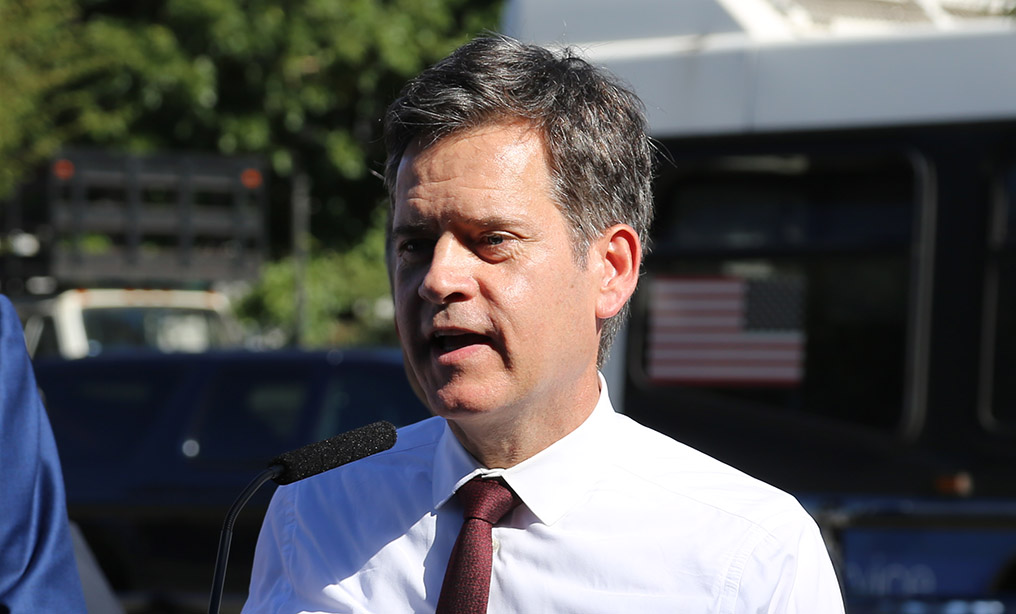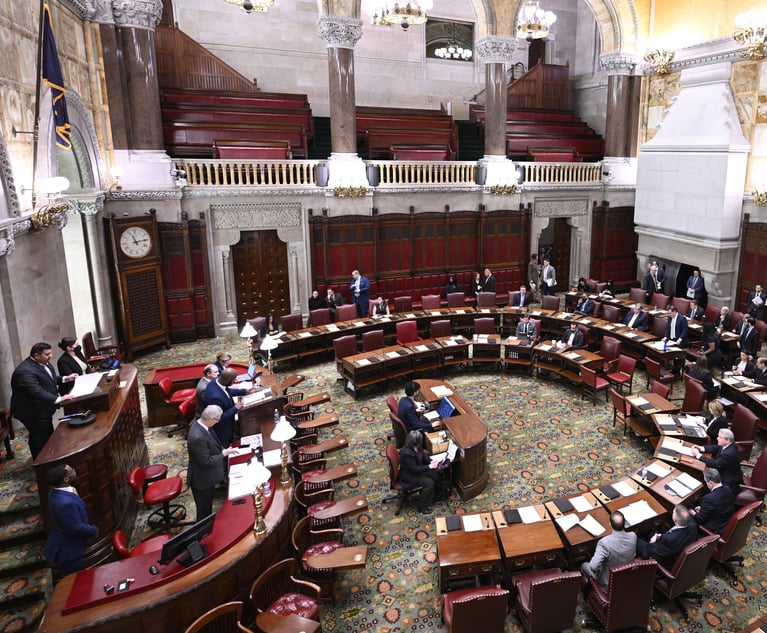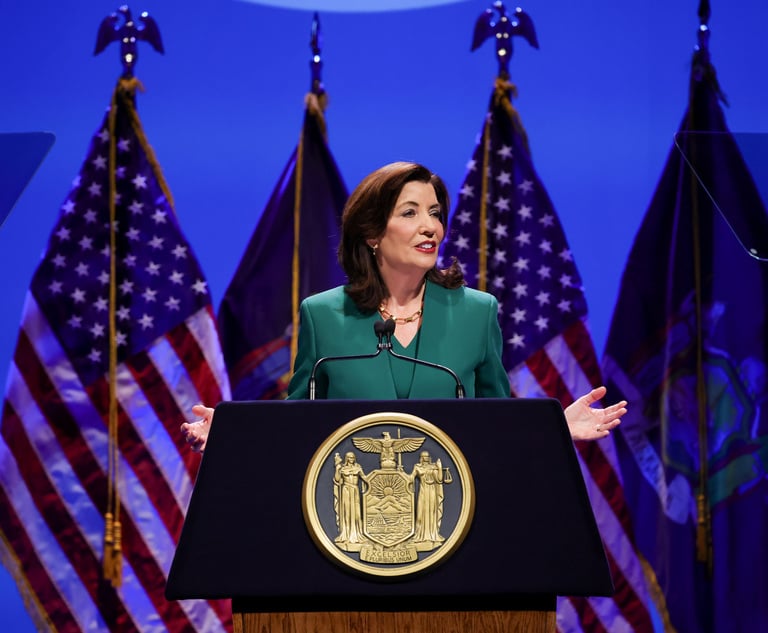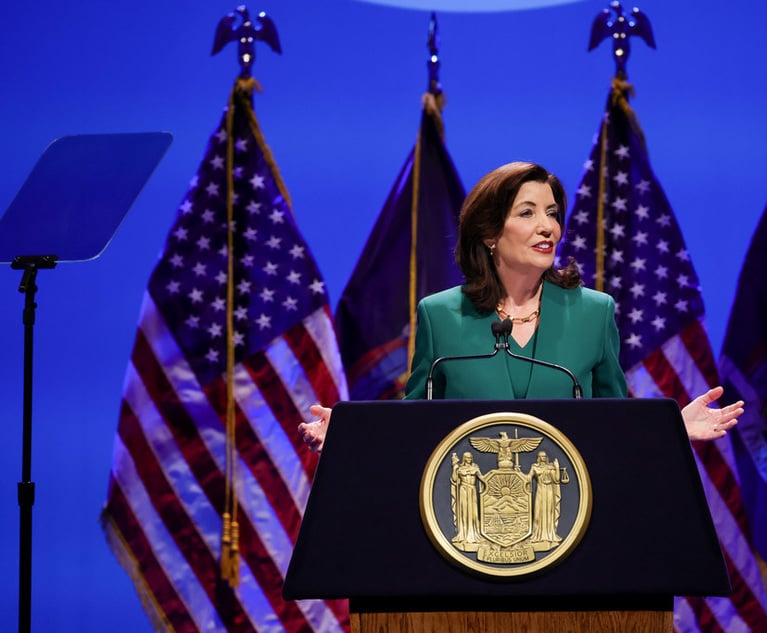NY Lawmakers See Court Reform, Assigned Counsel Rate Hike With Favor
State Sen. Brad Hoylman, a Democrat from Manhattan who chairs the Judiciary Committee, said he's considering holding hearings on restructuring the state's trial courts.
March 01, 2019 at 03:11 PM
6 minute read
 Sen. Brad Hoylman. Photo: NYCDOT/flickr
Sen. Brad Hoylman. Photo: NYCDOT/flickr
New York state lawmakers in Albany have responded positively in the immediate aftermath of an ambitious set of proposals pitched by Chief Judge Janet DiFiore in her State of the Judiciary speech this week that would require their approval, including higher pay for attorneys assigned to represent indigent defendants and a major restructuring of the New York judicial system.
State Sen. Brad Hoylman, D-Manhattan, who chairs the Judiciary Committee in his chamber, said he's considering holding hearings on the latter issue, which was first proposed formally more than two decades ago when Judith Kaye was chief judge.
“I am strongly supportive of court reform and appreciate the chief judge following her predecessor's lead and continuing to seek changes that would be initiated by the state Legislature,” Hoylman said. “I'm not stopping, I'm actually digging into the issue and figuring out a way to hold hearings and move these proposals forward.”
The proposal, as described by DiFiore, would consolidate the state's current structure of 11 different trial courts down to just two: a Supreme Court, which would handle most matters involving criminal, civil, family and other areas; and a District Court, which would handle housing and more minor cases.
The idea of court reorganization has been floated by officials in the state judiciary for decades with little movement among lawmakers, who would have to approve an amendment to the state constitution to enact such a change.
The process for doing so in New York is not a short one. A constitutional amendment would have to be approved by the current Legislature, which just took office in January, and then again by the next class of state lawmakers in 2021. The amendment would then go to voters to approve later that year, meaning it wouldn't take effect until 2022 at the earliest.
Assemblyman Jeffrey Dinowitz, a Democrat from the Bronx who chairs the Assembly Judiciary Committee, said that while the process of enacting court reform may by lengthy, it's one that needs to finally be discussed by the Legislature.
“It's kind of stupid to me to have such a large variety of courts and judgeships when it probably impedes the efficient operation of justice by doing it that way,” Dinowitz said. “I think it's a longer-term discussion, but we should discuss it.”
Related to court reform, both Dinowitz and Hoylman agree that state lawmakers should also consider changing a formula enshrined in the state constitution that allows for only one state supreme court justice for every 50,000 residents in each judicial district. The formula has been used for more than half a century in New York.
“That doesn't makes sense because it was written at a time when populations were much lower. But you also have to take into account the number of cases,” Dinowitz said. “You have to look at the larger picture of the population and what the needs are.”
There may be more cases before a supreme court justice in the Bronx, for example, than one in Hamilton County. Both officials have the same duties, but one may be faced with significant backlog because of a higher caseload, Dinowitz said.
Hoylman argued that increasing the number of justices could also be seen as a cost-saving measure, as much as it would improve efficiency in state courts. He criticized the current practice that's commonly used in the judiciary to pull justices appointed to the Court of Claims and name them acting state supreme court justices to help manage areas where cases can pile up.
“It's like judicial whack-a-mole,” Hoylman said. “That should be the last resort to have judges filling in, in this matter, but it's become part of the formula essentially to make sure there are enough supreme court justices.”
The practice has been criticized in the past by some lawmakers who argued that it takes the decision out of the hands of voters, who elect state supreme court justices. Court of Claims judges, meanwhile, are appointed by the governor and confirmed by the Senate.
“The current system of appointing Court of Claims justices to serve as supreme court justices is not acceptable,” Hoylman said.
Changing the formula for the number of state supreme court justices would also require a constitutional amendment, but at least one other proposal from DiFiore would not.
Assigned counsel, also referred to as 18-B attorneys, could see an increase in their hourly compensation rate in this year's state budget. Dinowitz and Hoylman both said the issue is being discussed among lawmakers as part of the spending plan, which is due at the end of March.
“That's actually a budget issue we're dealing with as we speak,” Hoylman said. “These attorneys haven't seen an increase in over a decade and it's hard to attract enough quality attorneys to take these difficult cases on unless you pay them more money.”
Those lawyers, who are private attorneys assigned to represent indigent people when a public defender has a conflict of interest, are currently paid between $60 and $75 an hour depending on the level of charge the defendant is facing. That hasn't changed since 2004.
Their federal counterparts, meanwhile, earn $140 an hour for their work on such cases and have received several pay hikes over the last two decades. Dinowitz agreed that it's time for the compensation rates to increase at the state level as well.
“Their compensation has to go up. It hasn't changed in years,” Dinowitz said. “What's been happening is because the rates haven't changed there are fewer and fewer lawyers who are willing to do that, and you get what you pay for, really.”
That decision, of course, can't be made unilaterally by either Hoylman or Dinowitz. But both said Democrats who control the state Assembly and Senate have started discussing the issue among other members in each chamber.
If approved, it would be incorporated into a final state budget, which is scheduled to be approved by lawmakers later this month. That spending plan will also include funding for the state judiciary, which requested a 2 percent increase from the Legislature this year. That would bring the total budget of the court system up to $2.28 billion in state operating costs.
Hoylman said, as of now, there appears to be optimism for the request in the Senate but that lawmakers are still in the midst of negotiations on a final spending plan for the state.
“I think at this stage there's widespread support for the proposal [in the Senate],” Hoylman said.
READ MORE:
DiFiore Renews Call for Lawmakers to Restructure NY Court System
NY Lawmakers Outlaw 'Revenge Porn,' Enact Civil Recourse for Victims
NY Lawmakers Delay Criminal Justice Reform While Differences Remain
This content has been archived. It is available through our partners, LexisNexis® and Bloomberg Law.
To view this content, please continue to their sites.
Not a Lexis Subscriber?
Subscribe Now
Not a Bloomberg Law Subscriber?
Subscribe Now
NOT FOR REPRINT
© 2025 ALM Global, LLC, All Rights Reserved. Request academic re-use from www.copyright.com. All other uses, submit a request to [email protected]. For more information visit Asset & Logo Licensing.
You Might Like
View All
Relaxing Penalties on Discovery Noncompliance Allows Criminal Cases to Get Decided on Merit
5 minute read
Bipartisan Lawmakers to Hochul Urge Greater Student Loan Forgiveness for Public-Interest Lawyers

'Playing the Clock'?: Hochul Says NY's Discovery Loophole Is to Blame for Wide Dismissal of Criminal Cases

So Who Won? Congestion Pricing Ruling Leaves Both Sides Claiming Victory, Attorneys Seeking Clarification
4 minute readTrending Stories
- 1We the People?
- 2New York-Based Skadden Team Joins White & Case Group in Mexico City for Citigroup Demerger
- 3No Two Wildfires Alike: Lawyers Take Different Legal Strategies in California
- 4Poop-Themed Dog Toy OK as Parody, but Still Tarnished Jack Daniel’s Brand, Court Says
- 5Meet the New President of NY's Association of Trial Court Jurists
Who Got The Work
J. Brugh Lower of Gibbons has entered an appearance for industrial equipment supplier Devco Corporation in a pending trademark infringement lawsuit. The suit, accusing the defendant of selling knock-off Graco products, was filed Dec. 18 in New Jersey District Court by Rivkin Radler on behalf of Graco Inc. and Graco Minnesota. The case, assigned to U.S. District Judge Zahid N. Quraishi, is 3:24-cv-11294, Graco Inc. et al v. Devco Corporation.
Who Got The Work
Rebecca Maller-Stein and Kent A. Yalowitz of Arnold & Porter Kaye Scholer have entered their appearances for Hanaco Venture Capital and its executives, Lior Prosor and David Frankel, in a pending securities lawsuit. The action, filed on Dec. 24 in New York Southern District Court by Zell, Aron & Co. on behalf of Goldeneye Advisors, accuses the defendants of negligently and fraudulently managing the plaintiff's $1 million investment. The case, assigned to U.S. District Judge Vernon S. Broderick, is 1:24-cv-09918, Goldeneye Advisors, LLC v. Hanaco Venture Capital, Ltd. et al.
Who Got The Work
Attorneys from A&O Shearman has stepped in as defense counsel for Toronto-Dominion Bank and other defendants in a pending securities class action. The suit, filed Dec. 11 in New York Southern District Court by Bleichmar Fonti & Auld, accuses the defendants of concealing the bank's 'pervasive' deficiencies in regards to its compliance with the Bank Secrecy Act and the quality of its anti-money laundering controls. The case, assigned to U.S. District Judge Arun Subramanian, is 1:24-cv-09445, Gonzalez v. The Toronto-Dominion Bank et al.
Who Got The Work
Crown Castle International, a Pennsylvania company providing shared communications infrastructure, has turned to Luke D. Wolf of Gordon Rees Scully Mansukhani to fend off a pending breach-of-contract lawsuit. The court action, filed Nov. 25 in Michigan Eastern District Court by Hooper Hathaway PC on behalf of The Town Residences LLC, accuses Crown Castle of failing to transfer approximately $30,000 in utility payments from T-Mobile in breach of a roof-top lease and assignment agreement. The case, assigned to U.S. District Judge Susan K. Declercq, is 2:24-cv-13131, The Town Residences LLC v. T-Mobile US, Inc. et al.
Who Got The Work
Wilfred P. Coronato and Daniel M. Schwartz of McCarter & English have stepped in as defense counsel to Electrolux Home Products Inc. in a pending product liability lawsuit. The court action, filed Nov. 26 in New York Eastern District Court by Poulos Lopiccolo PC and Nagel Rice LLP on behalf of David Stern, alleges that the defendant's refrigerators’ drawers and shelving repeatedly break and fall apart within months after purchase. The case, assigned to U.S. District Judge Joan M. Azrack, is 2:24-cv-08204, Stern v. Electrolux Home Products, Inc.
Featured Firms
Law Offices of Gary Martin Hays & Associates, P.C.
(470) 294-1674
Law Offices of Mark E. Salomone
(857) 444-6468
Smith & Hassler
(713) 739-1250






